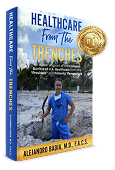Golfing can oftentimes be a pain in the links. But, advanced treatments to correct aggravating musculoskeletal conditions, especially of the hand, wrist, elbow and shoulder, are returning professional and weekend athletes to the course more quickly, says noted hand and upper limb orthopedic surgeon Alejandro Badia MD.
One such treatment approach – the minimally invasive Tenex procedure – relieves painful, chronic tendonitis in an elbow, shoulder or wrist – a common complaint of golfers – using ultrasonic energy.
With a special instrument inserted through a pinhole incision, the surgeon applies the energy in an outpatient setting to break down and remove damaged tendon tissue, explains Dr. Badia, founder and chief medical officer of the Badia Hand to Shoulder Center and OrthoNOW®.
For golfers and other patients who develop persistent shoulder pain caused by rotator cuff stress and disease, Dr. Badia has been effectively treating the problem with a bovine-collagen bio-inductive implant – about the size of a postage stamp.
This implant promotes new tendon growth in the shoulder joint and can either halt progression of rotator cuff disease or prevent re-tearing of a tendon that has been surgically repaired,” he says.
Other treatment advances include harnessing a patient’s own natural defenses to mitigate joint inflammation, relieve chronic musculoskeletal pain and repair orthopedic injuries. Dr. Badia, an expert in orthobiologics and regenerative medicine, has achieved successful outcomes by injecting stem cell derived products and platelet rich plasma into diseased joints.
“The interplay between bones, ligaments, tendons and soft tissue in a joint is complex,” says Dr. Badia, who has treated musculoskeletal problems in both amateur and professional athletes.
Golf requires harmonic use of shoulder, hand and wrist. Even though the game is a low-impact sport, the explosiveness of the swing while gripping a club can put tremendous stress on joint infrastructure and cause a surprisingly high percentage of painful injuries.”
Statistics bear that out. The literature reports that as many as 27 percent of golfers develop “golfer’s elbow,” due to repetitive use of flexor tendons in the forearm during a golf swing.
Another 19 percent experience shoulder injury. But, Dr. Badia says deep wrist pain is the most common golfer complaint.
In fact, epidemiological studies indicate that, in right-handed golfers, male and female, the left wrist is one of the most usual sites of injury. In male golfers, left-shoulder problems also commonly occur.
Some experts blame improper golf-swing mechanics for injuries, especially among amateurs, but, more commonly, orthopedic issues develop as a result of musculature and joint overuse or the exacerbation of other underlying conditions, such as arthritis, bursitis, tendonitis and carpal tunnel syndrome, explains Dr. Badia.
Especially susceptible to injury are older golfers who often have age-related joint disorders unrelated to the game – like osteoarthritis, which breaks down joint cartilage over time – and who tend to golf more frequently than younger counterparts, Dr. Badia says.
Golfing can aggravate underlying tendonitis of the fingers or wrist or osteoarthritis of the hand, causing these conditions to become exceedingly painful and leading to weakness in the hand and loss of grip strength,” Dr. Badia says.
For a person who has carpal tunnel syndrome (CTS), a nerve compression disorder at the wrist, an 18-hole golf game can increase CTS symptoms, resulting in numbness and a cramped feeling in the hand.
Standard treatments for relieving mild or moderate joint pain include application of moist heat or ice to affected joints, use of over-the-counter non-steroidal anti-inflammatory drugs or prescribed medications, rest, physical therapy and range-of-motion exercises.
If conservative approaches fail and the pain becomes chronic or severe, the patient should see an orthopedic specialist as soon as possible for appropriate diagnosis and treatment, Dr. Badia emphasizes.
To reduce risk of injury and extend one’s years of playing time on the golf course, Dr. Badia suggests:
- Learn to play golf properly. Maintain good posture. Power the golf swing smoothly, using all muscle groups rather than depending on one or two joints. Don’t overswing.
- Warm up for at least 10 minutes prior to play. Stretch hands, arms, elbows, shoulders.
- Do strength-training and flexibility exercises at least several times a week – daily, if possible.
- Lift and carry golf clubs carefully. Golfers hauling their own clubs are at greater risk of developing shoulder and back problems.
- Avoid spending hours perfecting a swing or driving balls on the range. Overdoing any activity is neither good for you – nor your game.
Bio: Alejandro Badia, MD, FACS, internationally renowned hand and upper-limb surgeon and founder of Badia Hand to Shoulder Center and OrthoNOW®, a walk-in orthopedic care clinic. He is a member the American Society for Surgery of the Hand, American Association for Hand Surgery and the American Academy of Orthopedic Surgeons. He is a specialist in treating all problems related to the hand and upper extremity including trauma, sports injury, joint reconstruction, nerve injuries and arthroscopic surgeries. OrthoNOWcare.com and https://drbadia.com.







